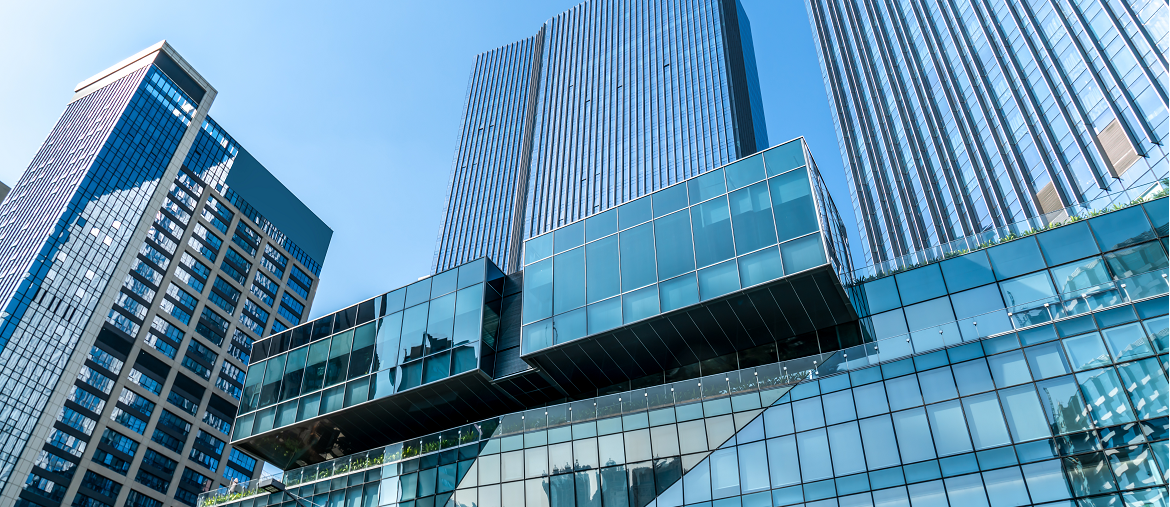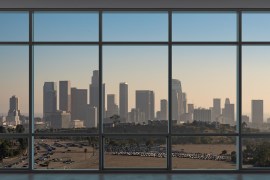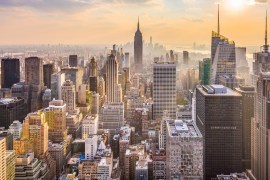Key Takeaways:
- 512 live-work-play communities were built across the nation since 2012, with another 101 in the pipeline for the next two years.
- Coworking made its way into 90 live-work-play developments between 2012 and 2023, catering to the rising demand for convenient and flexible workspaces.
- New York City is currently home to the highest number of mixed-use buildings (50, with four of them planned for 2023), five of which include coworking spaces.
- At the national level, office areas in live-work-play developments make up 38% of the total square footage; however, Seattle tops that with a whopping 61%.
With so many workers going remote in the last couple of years, getting people back into the office is certainly a challenge — and one that’s often greeted with the counterargument of long, tedious commutes. Luckily, the past few years have also served as an accelerator for the rise of live-work-play (LWP) developments, which cater to people’s need for immediacy and convenience. Often serving as “vertical villages” due to their ability to foster actual communities under one roof, mixed-use buildings ensure that residents and workers have everything at hand — from residential to office spaces, as well as retail and entertainment. As such, the switch from workstyle to lifestyle is not only easy, but also incredibly quick.
Granted, having a one-stop shop for all everyday activities is not a new concept. However, it is one that has taken off significantly in recent years: a whopping 512 LWP developments were built in the last decade nationwide, and another 101 are in the works through 2024. In fact, 2022 claimed an all-time high in terms of LWP construction, with 72 such developments being completed or close to completion this year. Even so, 2023 is primed to top even that with 73 mixed-used buildings in the pipeline. What’s more impressive is that three-quarters of the LWP properties built in since 2012 have class A ratings, which ensure higher quality, modern amenities and new technology.
As coworking spaces have recently exploded across the nation, 88 of them were included in mixed-use buildings since 2012. And, while the LWP trend (as well as the coworking trend) took a slight hit in 2021 due to COVID-19, both of these areas rose again in 2022. Thus, 10 new coworking spaces were integrated into LWP developments this year, with two more in the pipeline for 2023.
The fusion between LWP and coworking is a natural response to the rising demand for flexible workspaces from remote workers, freelancers, startups or smaller businesses. In many cases, a coworking space in an LWP building is a more convenient arrangement than a single, larger company providing an office space there that would only benefit employees who also happen to be residents in said building. Conversely, coworking spaces welcome workers from any and all companies.
Residential Use Dominates LWP Developments, But Office Spaces Overpower Multifamily in New York & Seattle
Nationally, the ratio between living space and work-play spaces in these buildings stands at 47% to 53%, respectively. As expected, multifamily units comprise the majority of the square footage in LWP developments. However, an impressive 38% of these spaces are made of offices and 15% are devoted to retail businesses. Despite this national distribution, some bustling cities still stand out as exceptions. For instance, in Seattle, office spaces are predominant in LWP buildings, taking up 61% of the total square footage. Meanwhile, apartment units occupy just one-third of the overall space and retail stands at only 5%. Similarly, mixed-use buildings in New York are also primarily composed of office spaces (58%), whereas the residential areas claim only 20% — the lowest share among the top 10 cities with the most LWP developments.
New York City Claims Most Coworking Spaces in LWP Communities, Followed by Chicago & Atlanta
To further explore the evolution of LWP and its intersection with the coworking segment, we determined the top U.S. cities with the highest number of LWP buildings in 2022, as well as their growth throughout the last decade and a glance at future constructions. In doing so, we were also able to reveal the difference in the distribution of various spaces using square footage, which gave us a clearer idea of the balance between residential and commercial use.
#1 New York City, NY – 50 LWP Developments
Bustling with skyrocketing urban developments, New York City is the ultimate leader when it comes to LWP communities. It’s also the perfect candidate to host them due to its density and the propensity to build upward rather than out. In 2023, the city will have logged a total of 50 such buildings — more than double that of the runner-up, Philadelphia. Here, the construction of LWP spaces throughout the last decade was constant, with slight peaks in 2018 and 2020. Despite a significant decrease in the number of LWP developments the following year (from seven in 2020 to only two in 2021), it appears that the post-pandemic era is set to follow an upward trend: six new LWP buildings opened in 2022, and there are already another four in the pipeline for next year.
While most of these spaces have traditional offices incorporated (58% of the total square footage), developers in New York City also focused on coworking areas. In fact, five of them were included in LWP developments in the last 10 years, which is the highest number of incorporated flexible workspaces in our ranking.
#2 Philadelphia, PA – 20 LWP Developments
As major tech companies like IBM have recently contributed to Philadelphia’s flourishing business scene, it’s no wonder that the “city of brotherly love” takes second place in terms of LWP developments. Here, 20 such spaces were built or will be built in between 2013 and 2024, with the highest number (four) completed in 2019. And although there was only one new building announced annually over the next four years, there are two scheduled for opening in 2024 – a possible sign of a healthy post-pandemic rebound.
Notably, among the LWP developments in Philadelphia, there’s now a rather balanced distribution in square footage breakdown between multifamily and office space, at 43% and 48%, respectively. Moreover, three-quarters of the mixed-use buildings in the city have a class A rating, highlighting the overall quality and modern amenities they provide to both residents and workers. That said, despite the high number of LWP communities in the city, coworking spaces have not yet taken root in this segment, as between 2012 and 2022, only one flexible workspace was developed in an LWP arrangement.
#3 Miami, FL – 17 LWP Developments
Since 2012, the Miami market added no less than 17 LWP developments, although the growth rate has been anything but consistent. The pandemic years seem to have amplified the popularity of the LWP concept, as five such constructions were finalized in 2022 and, of the total of 17 built since 2012, four more are in the works for 2023. The pre-COVID trend for the live-work-play lifestyle had a barely palpable effect, with hiatuses of up to three years between LWP deliveries. Perhaps also revealing of Miami’s hesitation to join the LWP bandwagon is the fact that only three of the 18 LWP developments built since 2012 included coworking spaces.
Known for its impressive skylines, state-of-the-art buildings and luxurious retail centers, it’s no surprise that 82% of the LWP developments in Miami have class A ratings — a sign that staying inside in the Magic City can be as gratifying as spending time outdoors.
# 4 Chicago, IL – 17 LWP Developments
As a major player in all business sectors, Chicago is home to plenty of Fortune 500 companies, which is likely a contributing factor to the development of LWP communities. Here, 17 mixed-use buildings will have been completed in between 2013 and 2024, with a record number of six in 2018. In four of these spaces, there’s also a coworking element, although coworking has not been growing steadily in LWP developments in Chicago. That might be because a whopping 66% of the total square footage in LWP developments here — the highest percentage among the top 10 cities with LWP spaces — is attributed to multifamily residential areas. That leaves less space for office use (only 19% of the total square footage) and 15% for retail.
Furthermore, Chicago is also one of the few cities with no LWP buildings under a B rating classification, which means that most of these developments benefit from modern amenities.
#5 Columbus, OH – 17 LWP Developments
Columbus also made the top 10 cities with the most LWP communities at their core. It had a total of 17 such developments since 2012, with the majority built or in the pipeline between 2018 and 2023. Yet, similarly to Philadelphia, only one of these included a coworking space. That’s a sign that this segment has yet to be fully embraced as part of the LWP concept here, despite the fact that 47% of the total square footage in LWP areas is made up of traditional office spaces.
At the same time, 14% of mixed-use buildings in Columbus are C-rated spaces, which is significantly more than the 3% national average of the last decade. Given that businesses, remote workers, and freelancers looking to transition to the coworking model are generally looking for modern amenities and high tech, this could be a factor that narrows their choices in Ohio’s state capital.
#6 Atlanta, GA – 16 LWP Developments
With Downtown Atlanta hosting major players of today’s business scene, the city currently has 14 LWP communities that cater to both residents and workers and two more are to be added next year. While the total number might not raise any eyebrows just yet, it’s important to note that one-quarter of those buildings in Atlanta also include coworking spaces. Consequently, that places Atlanta right after New York City in the coworking department.
This year, there were no new LWP developments in the city. However, three new such buildings were introduced in 2020, followed by another two in 2021 – just in time for the massive demand growth brought about by the pandemic. Looking forward, Atlanta has two more mixed-use buildings in the books for 2023. But, most impressively, it’s the only city in our ranking with 100% class A ratings for all of its LWP buildings.
#7 Seattle, WA – 15 LWP Developments
Seattle’s most pronounced growth in terms of LWP buildings occurred between 2016 and 2019, followed by a gap year in 2020. Then, two and three more LWP communities were added to the city in 2020 and 2021, respectively. With a total of 15 LWP developments built in the last decade, Seattle is yet another city that seems to revolve mostly around traditional office spaces or independent coworking areas, as only two flexible workspaces have been included in LWP buildings since 2012.
That said, office spaces dominate the existing mixed-use buildings by a whopping 61%. That’s the highest percentage among the top 10 cities in our ranking and well above the national average. Conversely, Seattle had the lowest percentage of LWP buildings with an A rating of those on our list, with only 54% of Seattle LWP buildings ensuring that level of quality.
#8 Denver, CO – 13 LWP Developments
Hardly any LWP developments were finished in Denver between 2012 and 2017. Nevertheless, 2018 fueled the beginning of a constant stream of this type of real estate projects in Denver. Three of those developments also include coworking spaces, all of which were completed before the start of the pandemic.
Denver is known as a great city for new businesses due to its favorable tax law, superior quality of life and lower cost of living. Accordingly, its LWP communities comprise one-third of office space, while nearly 60% of the space is for multifamily purposes.
#9 Cleveland, OH – 10 LWP Developments
Marking Ohio’s second appearance in our ranking, Cleveland had an inconsistent evolution in terms of LWP buildings, with a slight peak in 2019, although 2023 is set to witness the completion of two more such spaces. However, of the total of 10 built in between 2013 and 2023, only two mixed-use developments host coworking spaces. Granted, traditional offices did claim their spot in LWP developments here, as the distribution in space in Cleveland is almost perfectly balanced, with 51% for residential use, 44% for office spaces and 5% for retail.
Cleveland is ruled by major healthcare, finance, and biotech companies, so it’s logical that the city blends business and lifestyle under the same roof. Here, 75% of LWP communities have A-class ratings, while 13% fall under the B category and another 13% receive C rankings.
#10 Portland, OR – 10 LWP Developments
Rounding out the top 10 cities with the most LWP developments, Portland is one of the nation’s hotspots when it comes to manufacturing. And while that might tip the balance towards industrial spaces overall, traditional offices are also part of the business footprint here. Specifically, 47% of the total square footage in LWP buildings is meant for office use, overpowering the residential purpose.
Portland’s LWP projects had a steady trajectory between 2013 and 2018, with at least one new space completed every year. But then, 2019 and 2020 didn’t bring any new developments, and only two were built in 2021. Moreover, the city is the only one on our list that still lacks any coworking component as part of LWP communities, keeping the focus on conventional office spaces.
You can check out the graphic below to see the year-by-year city-level construction of LWP developments in the top 10 cities from our ranking:
What the Experts Say
Doug Ressler, Business Intelligence Manager - Yardi Matrix
Bringing retail space and micro-fulfillment distribution centers within a mixed-use development is a smart trend worth watching, because “both thrive when located on primary commercial arterials and in areas with strong demographics”, according to a new NAIOP report on e-commerce.
While the pandemic blurred the lines between living, working, and playing, rental communities that include residential, office and retail space have more than doubled in demand throughout the United States just over the past decade.
These units, also known as live-work-play (LWP) apartments, have seen a substantial increase in interest, especially among millennials.
LWP apartments present a unique opportunity to blend accessibility with desirable living experiences, world-class amenities, communal green spaces and exciting restaurant, retail, and entertainment options.
Methodology
- To compile this report, we extracted data from CommercialEdge and Yardi Matrix.
- We focused on mixed-use buildings, more precisely, buildings where the total space is shared between residential areas, office spaces and retail ones.
- To determine the evolution of live-work-play developments across the country, we went back to 1900 and followed the construction growth of these buildings until the present day and also the ones that are in the pipeline until 2026.
- We kept the main focus on developments that were built since 2012 and observed how the pandemic impacted this sector in the top U.S. cities with the highest total number of LWP communities.
- At the same time, we analyzed the number of coworking spaces included in LWP developments, to reveal the evolution of flexible workspaces.







